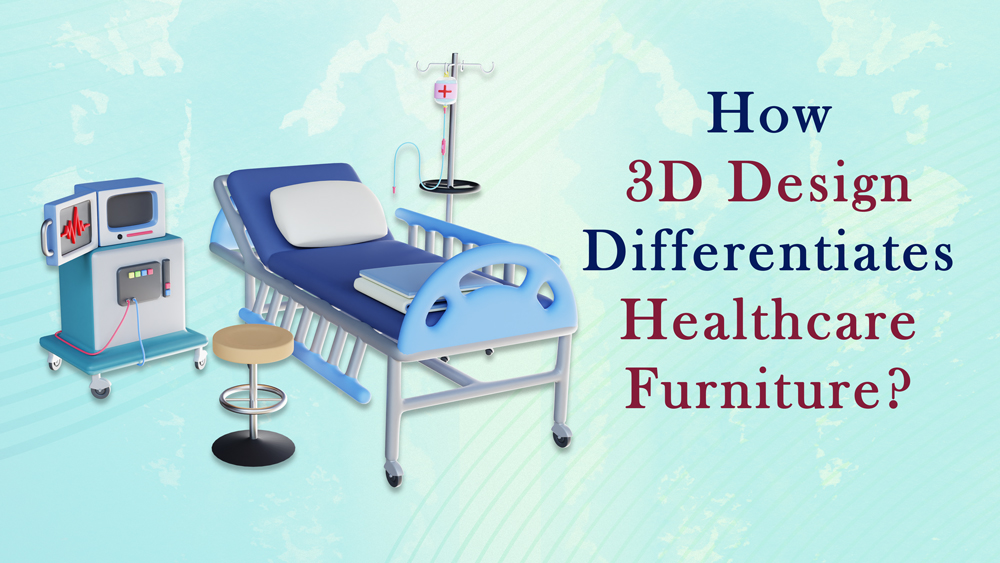
The manufacturing, engineering, and healthcare industries have all undergone radical transformations since the introduction of 3D printing technology. Healthcare furniture design is one area that has advanced significantly, though. Furniture designers may now develop complicated and elaborate patterns previously unattainable with standard manufacturing techniques thanks to 3D printing. We will discuss the various uses of 3D models in the healthcare industry and their significant influence on patient care in this writing.
3D Modeling: What is it?
To begin, let us define 3D modeling. The process of producing three-dimensional images of a surface or an object is known as 3D modeling. Computer-based 3D modeling software creates 3D models. You can ascertain the size, shape, and texture of an object while it is being 3D-modelled. The procedure uses polygons, lines, and points to construct 3D shapes inside the program.
How is 3D modeling Done?
Vertices are the basic building blocks of 3D furniture design. They join to form a mesh that serves as the model’s center. You can alter the shape of the model by adjusting each point. The software locates each vertical and horizontal position about a reference point. Typically, a 3D model starts with a simple shape, such as a cube, box, sphere, or any other shape you see appropriate. You can begin shaping and perfecting it from your initial shape to achieve your desired outcome.
Advantages of Designing Healthcare Furniture with 3D Modeling
The 3D modeling services, including 3D CAD modeling of healthcare furniture, have several advantages. Compared to using actual prototypes, 3D helps designers explore and test ideas more quickly and effectively. Since most of the furniture 3D design software is non-destructive, working with a model during the process is simple and allows for quick modification and undoing. Among the other advantages are:
- Design Summary
Architects may optimize project solutions and investigate various design choices with 3D. They can assess the object’s functioning and beauty by viewing how it will appear in real life.
- Error Detection
Construction of a 3D model happens virtually. It implies that any mistakes or inconsistencies in the design will become apparent throughout the development stage. Is there a problem coordinating space? Are there any issues with the structural components? If so, you’re more likely to learn about them online than on the building site.
- Separation of Time
Engineers and designers can visually test various ideas, forms, materials, features, and more. It typically only requires a few clicks and saves money and time as compared to actual prototypes. Due to this, the product has stood apart from the rivals as it can hit the market sooner.
- Realistic Furniture Rendition
Iteasier for the healthcare industry to select a customized piece of furniture if they see the product beforehand, even before they are built. The 3D designers can improve the communication with the client and make sure they are fully satisfied with the product.
- Enhances Environment with the 3D Furniture Design Drawing
Healthcare industries require good imagery for picking up the most appropriate furniture for the patients. With the correct tools, 3D designs can replace the necessity of expensive and timely photoshoots virtually, helping to improve healthcare furniture design by offering realistic, customizable visualizations.
- Select from an Online Catalogue and Virtual Showrooms
Industries are using 3D renderings, and the healthcare industry is included. It has become a standard practice even for the healthcare sector to select furniture online and from catalogs. With the technology improvement, you can implement the best features like augmented reality (AR) for converting customers.
Which software is the best for 3D models?
3D furniture design complet with any 3D program that includes capabilities for surface modeling. Architects and other manufacturing professionals have traditionally used CAD software. The same time, VFX and game artists typically utilize Maya, 3DSMax, and Adobe Substance 3D Painter—which is a terrific way to create textures and materials for your furniture.
Conclusion
It is impossible to overestimate the importance of 3D furniture design services in the healthcare sector. The 3D models support a more accurate and individualized approach to healthcare furniture by improving surgical planning and medical education. Don’t hesitate to Get in touch with us, our expert team will get back to you within 24 hours.